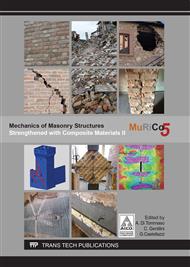p.628
p.638
p.646
p.653
p.662
p.670
p.678
p.686
p.694
Criteria for the Repair of Damage to Masonry Walls of Buildings Affected by Earthquakes Using Composite Materials with Inorganic Matrix
Abstract:
After the inspections to the damage caused by the last earthquake in Ecuador, and considering the construction typologies of reinforced concrete buildings in Guayaquil and Manta (Ecuador), in order to rebuild or repair the masonry walls we must resort to composite materials with inorganic matrix (cementitious). Composite materials in FRP with an organic matrix (epoxy) are not appropriate because, with an increase of strength they have a brittle behavior, therefore without possibility of energy dissipation not having the ductility provided by a metallic mesh or cobalt-metallic mesh, which have the advantage of using it with a cementitious matrix of frequent use in the current technology. Since the photographic records and the design of those masonry structures allow determining in detail the dynamics of the damage, it is possible to add to the theoretical analysis an experimental verification on the behavior of masonry walls with reinforced plastering with FRP or with metallic mesh with inorganic matrix under seismic actions.
Info:
Periodical:
Pages:
670-677
Citation:
Online since:
July 2017
Authors:
Price:
Сopyright:
© 2017 Trans Tech Publications Ltd. All Rights Reserved
Share:
Citation:


